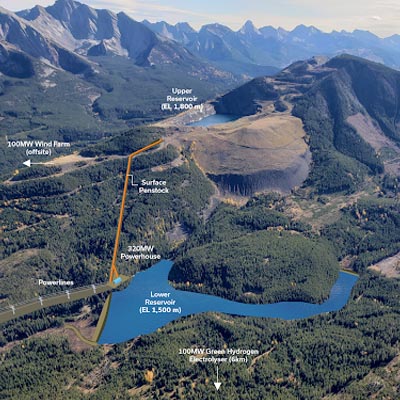Wind farm planned for Peace region
A $480 million wind project could blow a gust of fresh air into the struggling Tumbler Ridge economy.

Juergen Puetter, CEO and President of Aeolis Wind Power Corporation. — Photo courtesy of Juergen Puetter
Quebec-based renewable power producer Boralex Inc. has teamed up with Aeolis Wind, B.C.’s pre-eminent wind power developer, to build what could become British Columbia’s largest wind farm, located approximately 40 kilometres southeast of Tumbler Ridge. Currently at the environmental assessment stage, the $480 million project could provide up to 200 person years of employment.
The two companies, working under the name Red Willow Wind Partnership, hope to complete regulatory permitting by 2016, start construction in 2017 and begin generating power by 2018. Once the wind turbines and supporting infrastructure are in place, the site will require eight full-time employees over the project’s proposed 40-year lifespan. In addition, short-term construction work would be a windfall to the tiny northern community, which has struggled mightily since Walter Energy closed two nearby coal mines last spring, laying off 700 employees.
Aeolis president and CEO Juergen Puetter said that when it comes to wind power, it’s just like real estate: location, location, location.
“You’re looking for that perfect combination of suitable terrain with the right wind speed, proximity to power lines and reasonable access,” said Puetter.
Having prospected and leased potential wind farm locations throughout BC, Puetter said the Peace Region offers world-class sites.
“It’s all about getting ridges that are flat with few or small trees,” he said, “and we found exactly that.”
In the case of this project, the ridges are located south of Stoney Lake and Highway 52. On these ridges the companies plan to build approximately 80 turbines, each standing 135 metres from base to hub, with rotors 126 metres in diameter.
The journey ahead
While Tumbler Ridge residents have responded positively to the news, Alistair Howard, manager of project development at Boralex, is quick to emphasize that the project is in the very early stages of development and that it faces several obstacles along the way to completion.
On the environmental front, some have raised concerns that the turbines will decimate local bat and bird populations and that the construction process will also threaten local wildlife. Puetter said that such concerns are overblown and technological developments are helping to mitigate them.
“The average house cat kills more birds each year than a wind turbine,” he said. “So do skyscrapers. In the early days, wind turbines had ladders on the towers that provided convenient places for birds of prey to perch. Then they would dive down and fly through the arc of the wind turbine and be struck out of the sky. Modern turbines have no ladders. They’re completely smooth, so there’s nowhere for birds to perch.”
As for bats, Puetter said that prior to considering an area for construction his company used ultrasound recorders to determine how many bats frequent the area. He also notes that bats fall prey to windmills because the rapid pressure changes at the tip of the turbine tends to disorient them. But the windmills proposed for the Tumbler Ridge site are so large and the blades will turn so slowly that this problem should be all but eliminated.
The project’s future also hinges on the companies working out an agreement with local First Nations, not to mention landing a contract to sell the electricity generated to BC Hydro. While Boralex and Aeolis are already consulting with the Moberly Lake Indian Band and Saulteau First Nation, the agreement with BC Hydro is far from a done deal. The Crown corporation says it is open in theory to renewable energy projects that make environmental and economic sense, but it already has a number of other big ticket projects on its plate, such as the $8.7 billion Site C dam, and its current plan does not anticipate significant increases in demand that would require them to procure a significant amount of power from outside sources.
Puetter is undeterred by such challenges.
“It is our contention that BC Hydro’s current forecast for energy is very, very low,” he said.
Furthermore, he said B.C., which currently generates 90 per cent of its power through hydroelectric projects, is ideally suited to wind power, with the province’s dams serving as enormous batteries during periods of low wind.
“When the wind blows, you reduce the flow in the dams. When the wind doesn’t blow, you let the water out. It’s loss-free storage,” Puetter said.
Even so, Puetter realizes it may take longer than anticipated for others to share his enthusiasm. But when they do, he’ll be ready.
“The early bird gets the worm,” he said. “That’s why we have a large portfolio of wind resources. Being the first, we got the best sites.”




